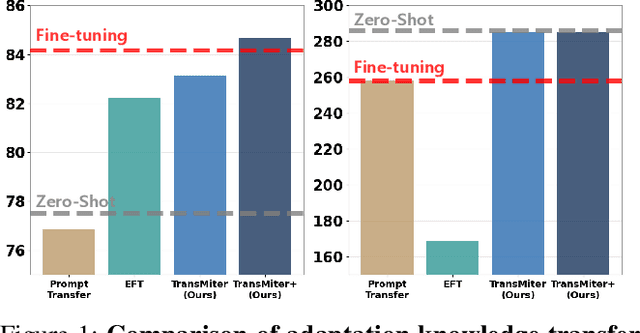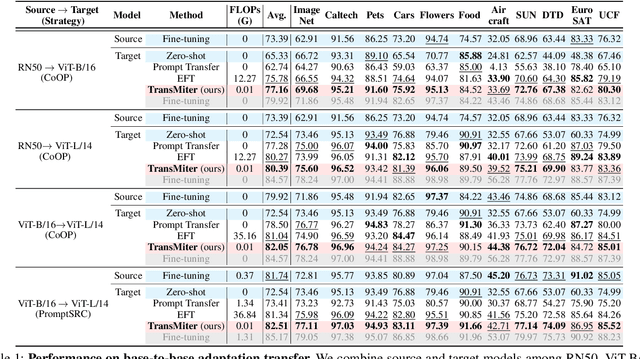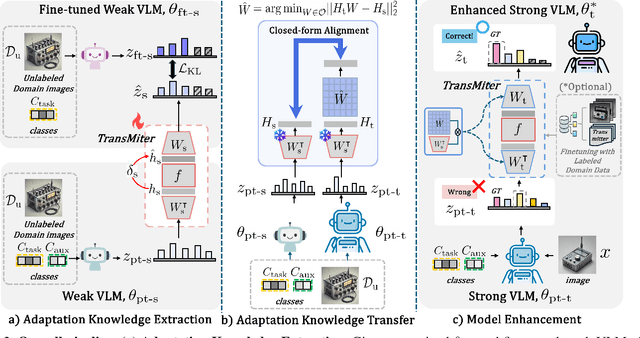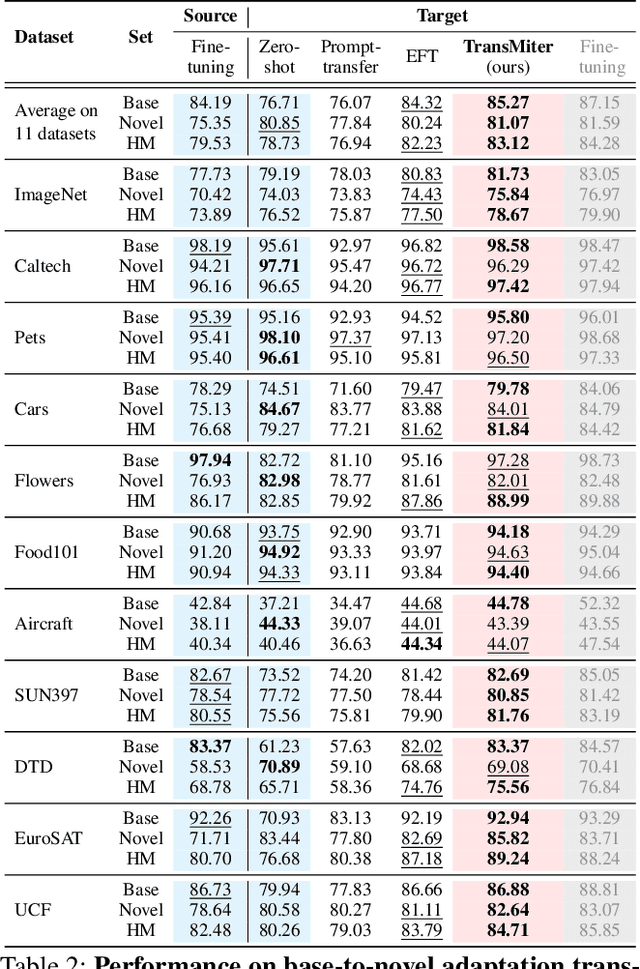Hyunwoo J. Kim
Transferable Model-agnostic Vision-Language Model Adaptation for Efficient Weak-to-Strong Generalization
Aug 13, 2025



Abstract:Vision-Language Models (VLMs) have been widely used in various visual recognition tasks due to their remarkable generalization capabilities. As these models grow in size and complexity, fine-tuning becomes costly, emphasizing the need to reuse adaptation knowledge from 'weaker' models to efficiently enhance 'stronger' ones. However, existing adaptation transfer methods exhibit limited transferability across models due to their model-specific design and high computational demands. To tackle this, we propose Transferable Model-agnostic adapter (TransMiter), a light-weight adapter that improves vision-language models 'without backpropagation'. TransMiter captures the knowledge gap between pre-trained and fine-tuned VLMs, in an 'unsupervised' manner. Once trained, this knowledge can be seamlessly transferred across different models without the need for backpropagation. Moreover, TransMiter consists of only a few layers, inducing a negligible additional inference cost. Notably, supplementing the process with a few labeled data further yields additional performance gain, often surpassing a fine-tuned stronger model, with a marginal training cost. Experimental results and analyses demonstrate that TransMiter effectively and efficiently transfers adaptation knowledge while preserving generalization abilities across VLMs of different sizes and architectures in visual recognition tasks.
When Model Knowledge meets Diffusion Model: Diffusion-assisted Data-free Image Synthesis with Alignment of Domain and Class
Jun 18, 2025Abstract:Open-source pre-trained models hold great potential for diverse applications, but their utility declines when their training data is unavailable. Data-Free Image Synthesis (DFIS) aims to generate images that approximate the learned data distribution of a pre-trained model without accessing the original data. However, existing DFIS meth ods produce samples that deviate from the training data distribution due to the lack of prior knowl edge about natural images. To overcome this limitation, we propose DDIS, the first Diffusion-assisted Data-free Image Synthesis method that leverages a text-to-image diffusion model as a powerful image prior, improving synthetic image quality. DDIS extracts knowledge about the learned distribution from the given model and uses it to guide the diffusion model, enabling the generation of images that accurately align with the training data distribution. To achieve this, we introduce Domain Alignment Guidance (DAG) that aligns the synthetic data domain with the training data domain during the diffusion sampling process. Furthermore, we optimize a single Class Alignment Token (CAT) embedding to effectively capture class-specific attributes in the training dataset. Experiments on PACS and Ima geNet demonstrate that DDIS outperforms prior DFIS methods by generating samples that better reflect the training data distribution, achieving SOTA performance in data-free applications.
Efficient multi-view training for 3D Gaussian Splatting
Jun 15, 2025Abstract:3D Gaussian Splatting (3DGS) has emerged as a preferred choice alongside Neural Radiance Fields (NeRF) in inverse rendering due to its superior rendering speed. Currently, the common approach in 3DGS is to utilize "single-view" mini-batch training, where only one image is processed per iteration, in contrast to NeRF's "multi-view" mini-batch training, which leverages multiple images. We observe that such single-view training can lead to suboptimal optimization due to increased variance in mini-batch stochastic gradients, highlighting the necessity for multi-view training. However, implementing multi-view training in 3DGS poses challenges. Simply rendering multiple images per iteration incurs considerable overhead and may result in suboptimal Gaussian densification due to its reliance on single-view assumptions. To address these issues, we modify the rasterization process to minimize the overhead associated with multi-view training and propose a 3D distance-aware D-SSIM loss and multi-view adaptive density control that better suits multi-view scenarios. Our experiments demonstrate that the proposed methods significantly enhance the performance of 3DGS and its variants, freeing 3DGS from the constraints of single-view training.
DeepVideo-R1: Video Reinforcement Fine-Tuning via Difficulty-aware Regressive GRPO
Jun 09, 2025Abstract:Recent works have demonstrated the effectiveness of reinforcement learning (RL)-based post-training in enhancing the reasoning capabilities of large language models (LLMs). In particular, Group Relative Policy Optimization (GRPO) has shown impressive success by employing a PPO-style reinforcement algorithm with group-based normalized rewards. However, the application of GRPO to Video Large Language Models (Video LLMs) has been less studied. In this paper, we explore GRPO for video LLMs and identify two primary issues that impede its effective learning: (1) reliance on safeguards, and (2) the vanishing advantage problem. To mitigate these challenges, we propose DeepVideo-R1, a video large language model trained with our proposed Reg-GRPO (Regressive GRPO) and difficulty-aware data augmentation strategy. Reg-GRPO reformulates the GRPO objective as a regression task, directly predicting the advantage in GRPO. This design eliminates the need for safeguards like clipping and min functions, thereby facilitating more direct policy guidance by aligning the model with the advantage values. We also design the difficulty-aware data augmentation strategy that dynamically augments training samples at solvable difficulty levels, fostering diverse and informative reward signals. Our comprehensive experiments show that DeepVideo-R1 significantly improves video reasoning performance across multiple video reasoning benchmarks.
Latent Bayesian Optimization via Autoregressive Normalizing Flows
Apr 21, 2025Abstract:Bayesian Optimization (BO) has been recognized for its effectiveness in optimizing expensive and complex objective functions. Recent advancements in Latent Bayesian Optimization (LBO) have shown promise by integrating generative models such as variational autoencoders (VAEs) to manage the complexity of high-dimensional and structured data spaces. However, existing LBO approaches often suffer from the value discrepancy problem, which arises from the reconstruction gap between input and latent spaces. This value discrepancy problem propagates errors throughout the optimization process, leading to suboptimal outcomes. To address this issue, we propose a Normalizing Flow-based Bayesian Optimization (NF-BO), which utilizes normalizing flow as a generative model to establish one-to-one encoding function from the input space to the latent space, along with its left-inverse decoding function, eliminating the reconstruction gap. Specifically, we introduce SeqFlow, an autoregressive normalizing flow for sequence data. In addition, we develop a new candidate sampling strategy that dynamically adjusts the exploration probability for each token based on its importance. Through extensive experiments, our NF-BO method demonstrates superior performance in molecule generation tasks, significantly outperforming both traditional and recent LBO approaches.
ST-VLM: Kinematic Instruction Tuning for Spatio-Temporal Reasoning in Vision-Language Models
Mar 26, 2025



Abstract:Spatio-temporal reasoning is essential in understanding real-world environments in various fields, eg, autonomous driving and sports analytics. Recent advances have improved the spatial reasoning ability of Vision-Language Models (VLMs) by introducing large-scale data, but these models still struggle to analyze kinematic elements like traveled distance and speed of moving objects. To bridge this gap, we construct a spatio-temporal reasoning dataset and benchmark involving kinematic instruction tuning, referred to as STKit and STKit-Bench. They consist of real-world videos with 3D annotations, detailing object motion dynamics: traveled distance, speed, movement direction, inter-object distance comparisons, and relative movement direction. To further scale such data construction to videos without 3D labels, we propose an automatic pipeline to generate pseudo-labels using 4D reconstruction in real-world scale. With our kinematic instruction tuning data for spatio-temporal reasoning, we present ST-VLM, a VLM enhanced for spatio-temporal reasoning, which exhibits outstanding performance on STKit-Bench. Furthermore, we show that ST-VLM generalizes robustly across diverse domains and tasks, outperforming baselines on other spatio-temporal benchmarks (eg, ActivityNet, TVQA+). Finally, by integrating learned spatio-temporal reasoning with existing abilities, ST-VLM enables complex multi-step reasoning. Project page: https://ikodoh.github.io/ST-VLM.
Super-class guided Transformer for Zero-Shot Attribute Classification
Jan 16, 2025



Abstract:Attribute classification is crucial for identifying specific characteristics within image regions. Vision-Language Models (VLMs) have been effective in zero-shot tasks by leveraging their general knowledge from large-scale datasets. Recent studies demonstrate that transformer-based models with class-wise queries can effectively address zero-shot multi-label classification. However, poor utilization of the relationship between seen and unseen attributes makes the model lack generalizability. Additionally, attribute classification generally involves many attributes, making maintaining the model's scalability difficult. To address these issues, we propose Super-class guided transFormer (SugaFormer), a novel framework that leverages super-classes to enhance scalability and generalizability for zero-shot attribute classification. SugaFormer employs Super-class Query Initialization (SQI) to reduce the number of queries, utilizing common semantic information from super-classes, and incorporates Multi-context Decoding (MD) to handle diverse visual cues. To strengthen generalizability, we introduce two knowledge transfer strategies that utilize VLMs. During training, Super-class guided Consistency Regularization (SCR) aligns model's features with VLMs using super-class guided prompts, and during inference, Zero-shot Retrieval-based Score Enhancement (ZRSE) refines predictions for unseen attributes. Extensive experiments demonstrate that SugaFormer achieves state-of-the-art performance across three widely-used attribute classification benchmarks under zero-shot, and cross-dataset transfer settings. Our code is available at https://github.com/mlvlab/SugaFormer.
VidChain: Chain-of-Tasks with Metric-based Direct Preference Optimization for Dense Video Captioning
Jan 12, 2025



Abstract:Despite the advancements of Video Large Language Models (VideoLLMs) in various tasks, they struggle with fine-grained temporal understanding, such as Dense Video Captioning (DVC). DVC is a complicated task of describing all events within a video while also temporally localizing them, which integrates multiple fine-grained tasks, including video segmentation, video captioning, and temporal video grounding. Previous VideoLLMs attempt to solve DVC in a single step, failing to utilize their reasoning capability. Moreover, previous training objectives for VideoLLMs do not fully reflect the evaluation metrics, therefore not providing supervision directly aligned to target tasks. To address such a problem, we propose a novel framework named VidChain comprised of Chain-of-Tasks (CoTasks) and Metric-based Direct Preference Optimization (M-DPO). CoTasks decompose a complex task into a sequence of sub-tasks, allowing VideoLLMs to leverage their reasoning capabilities more effectively. M-DPO aligns a VideoLLM with evaluation metrics, providing fine-grained supervision to each task that is well-aligned with metrics. Applied to two different VideoLLMs, VidChain consistently improves their fine-grained video understanding, thereby outperforming previous VideoLLMs on two different DVC benchmarks and also on the temporal video grounding task. Code is available at \url{https://github.com/mlvlab/VidChain}.
EfficientViM: Efficient Vision Mamba with Hidden State Mixer based State Space Duality
Nov 22, 2024



Abstract:For the deployment of neural networks in resource-constrained environments, prior works have built lightweight architectures with convolution and attention for capturing local and global dependencies, respectively. Recently, the state space model has emerged as an effective global token interaction with its favorable linear computational cost in the number of tokens. Yet, efficient vision backbones built with SSM have been explored less. In this paper, we introduce Efficient Vision Mamba (EfficientViM), a novel architecture built on hidden state mixer-based state space duality (HSM-SSD) that efficiently captures global dependencies with further reduced computational cost. In the HSM-SSD layer, we redesign the previous SSD layer to enable the channel mixing operation within hidden states. Additionally, we propose multi-stage hidden state fusion to further reinforce the representation power of hidden states, and provide the design alleviating the bottleneck caused by the memory-bound operations. As a result, the EfficientViM family achieves a new state-of-the-art speed-accuracy trade-off on ImageNet-1k, offering up to a 0.7% performance improvement over the second-best model SHViT with faster speed. Further, we observe significant improvements in throughput and accuracy compared to prior works, when scaling images or employing distillation training. Code is available at https://github.com/mlvlab/EfficientViM.
Inversion-based Latent Bayesian Optimization
Nov 08, 2024



Abstract:Latent Bayesian optimization (LBO) approaches have successfully adopted Bayesian optimization over a continuous latent space by employing an encoder-decoder architecture to address the challenge of optimization in a high dimensional or discrete input space. LBO learns a surrogate model to approximate the black-box objective function in the latent space. However, we observed that most LBO methods suffer from the `misalignment problem`, which is induced by the reconstruction error of the encoder-decoder architecture. It hinders learning an accurate surrogate model and generating high-quality solutions. In addition, several trust region-based LBO methods select the anchor, the center of the trust region, based solely on the objective function value without considering the trust region`s potential to enhance the optimization process. To address these issues, we propose Inversion-based Latent Bayesian Optimization (InvBO), a plug-and-play module for LBO. InvBO consists of two components: an inversion method and a potential-aware trust region anchor selection. The inversion method searches the latent code that completely reconstructs the given target data. The potential-aware trust region anchor selection considers the potential capability of the trust region for better local optimization. Experimental results demonstrate the effectiveness of InvBO on nine real-world benchmarks, such as molecule design and arithmetic expression fitting tasks. Code is available at https://github.com/mlvlab/InvBO.
 Add to Chrome
Add to Chrome Add to Firefox
Add to Firefox Add to Edge
Add to Edge